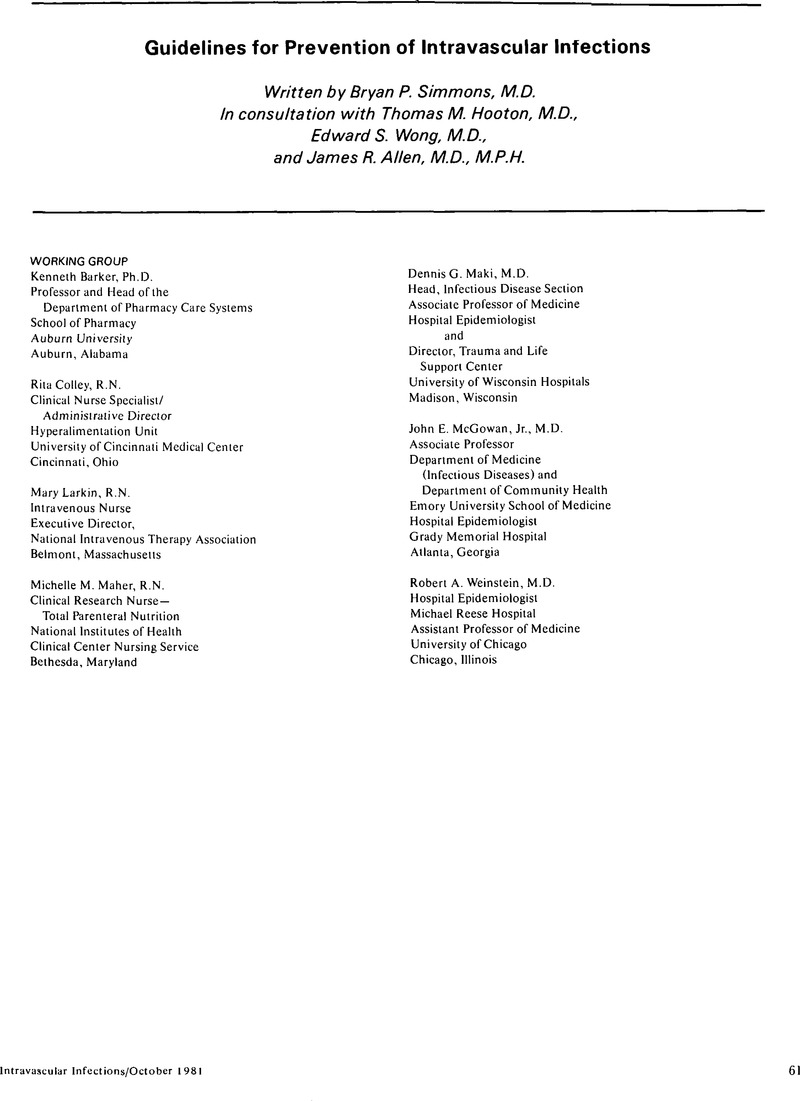Crossref Citations
This article has been cited by the following publications. This list is generated based on data provided by Crossref.
McGowan, John E.
1982.
Cosst and benefit—a critical issue for hospital infection control.
American Journal of Infection Control,
Vol. 10,
Issue. 3,
p.
100.
Haley, Robert W.
and
Williams, Walter W.
1982.
The preceding letter was referred to the Centers for Disease Control for a reply.
Infection Control,
Vol. 3,
Issue. 6,
p.
446.
Highsmith, Anita K.
Greenhood, Gary P.
and
Allen, James R.
1982.
Growth of Nosocomial Pathogens in Multiple-Dose Parenteral Medication Vials.
Journal of Clinical Microbiology,
Vol. 15,
Issue. 6,
p.
1024.
Adachi, Nora
Haley, Robert W.
and
Williams, Walter W.
1982.
CDC Guideline Recommendation Questioned.
Infection Control,
Vol. 3,
Issue. 6,
p.
446.
Nyström, B.
Olesen Larsen, S.
Dankert, J.
Daschner, F.
Greco, D.
Grönroos, P.
Jepsen, O.B.
Lystad, A.
Meers, P.D.
and
Rotter, M.
1983.
Bacteraemia in surgical patients with intravenous devices: A European multicentre incidence study.
Journal of Hospital Infection,
Vol. 4,
Issue. 4,
p.
338.
Rhame, Frank S.
1983.
Comments.
American Journal of Infection Control,
Vol. 11,
Issue. 5,
p.
193.
Burke, John P.
1983.
John P. Burke, MD, replies.
Infection Control,
Vol. 4,
Issue. 5,
p.
359.
Sebben, Jack E.
1983.
Surgical antiseptics.
Journal of the American Academy of Dermatology,
Vol. 9,
Issue. 5,
p.
759.
Friedland, Gerald
von Reyn, C. Fordam
Levy, Barry
Arbeit, Robert
Dasse, Priscilla
and
Crumpacker, Clyde
1984.
Nosocomial Endocarditis.
Infection Control,
Vol. 5,
Issue. 6,
p.
284.
Lindsey, Ronald W
and
Leach, John A
1984.
Sternoclavicular Osteomyelitis and Pyoarthrosis as a Complication of Subclavian Vein Catheterization: A Case Report and Review of the Literature.
Orthopedics,
Vol. 7,
Issue. 6,
p.
1017.
Ausman, Robert K.
1984.
Intravascular Infusion Systems.
p.
103.
Gantz, Nelson M.
Presswood, Grace M.
Goldberg, Robert
and
Doern, Gary
1984.
Effects of dressing type and change interval on intravenous therapy complication rates.
Diagnostic Microbiology and Infectious Disease,
Vol. 2,
Issue. 4,
p.
325.
Adams, Rebecca H
and
Fry, Donald E
1984.
Surgical Suite Reconstruction: Infection Control.
AORN Journal,
Vol. 39,
Issue. 5,
p.
868.
Reingold, Arthur L.
Kane, Mark A.
and
Hightower, Allen W.
1984.
Disinfection procedures and infection control in the outpatient oral surgery practice.
Journal of Oral and Maxillofacial Surgery,
Vol. 42,
Issue. 9,
p.
568.
Nahata, Milap C.
Winters, Cora B.
and
Powell, Dwight A.
1984.
Education Improved Use of Prophylactic Antibiotics.
Journal For Healthcare Quality,
Vol. 6,
Issue. 3,
p.
4.
Frawley, Loretta W.
1985.
Cost-effective application of the centers for disease control guideline for prevention of intravascular infections.
American Journal of Infection Control,
Vol. 13,
Issue. 6,
p.
275.
Williams, Walter W.
1985.
Infection Control during Parenteral Nutrition Therapy.
Journal of Parenteral and Enteral Nutrition,
Vol. 9,
Issue. 6,
p.
735.
Nahata, Milap C.
Winters, Cora B.
and
Powell, Dwight A.
1985.
Variation in Prophylactic Antibiotic Use in Pediatric Orthopedic Surgery.
Drug Intelligence & Clinical Pharmacy,
Vol. 19,
Issue. 11,
p.
834.
Simmons, Bryan
1985.
Alternative to IV Filter Usage.
Infection Control,
Vol. 6,
Issue. 9,
p.
342.
Weems, J J
Chamberland, M E
Ward, J
Willy, M
Padhye, A A
and
Solomon, S L
1987.
Candida parapsilosis fungemia associated with parenteral nutrition and contaminated blood pressure transducers.
Journal of Clinical Microbiology,
Vol. 25,
Issue. 6,
p.
1029.



